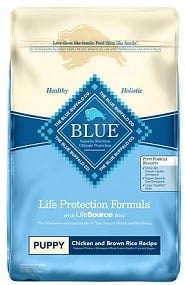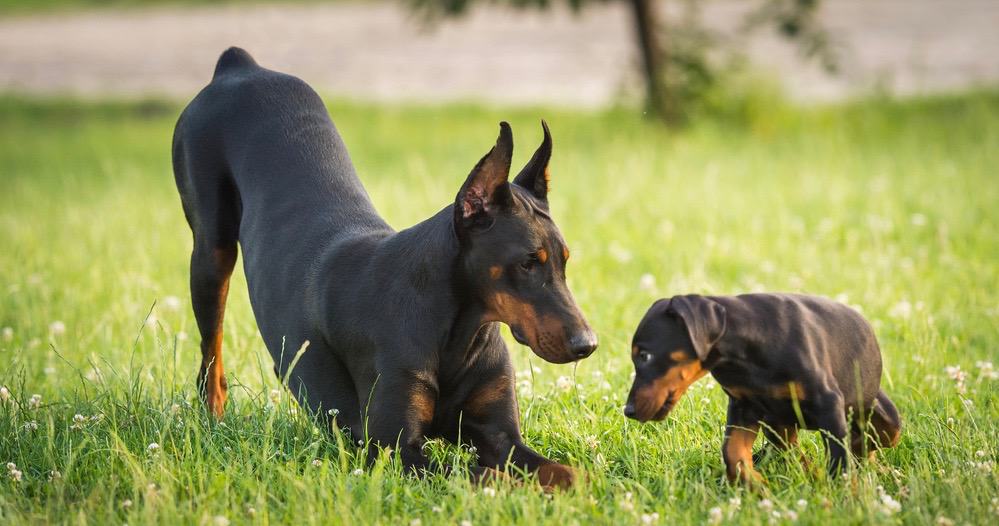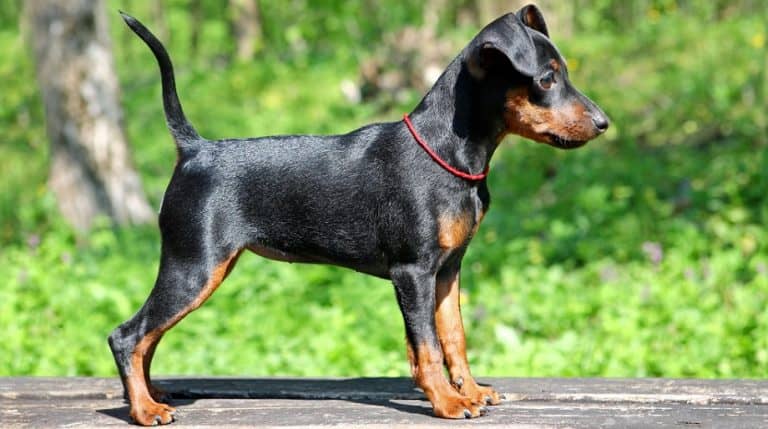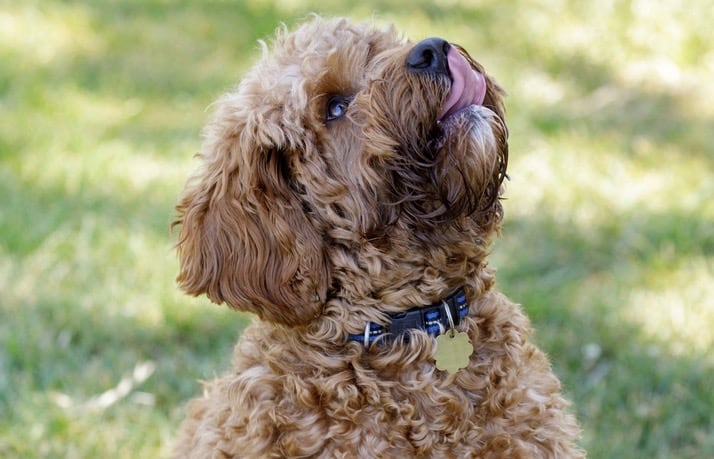Doberman Growth Chart (Weight Chart) – When Do Dobermans Stop Growing
Many people have a wrong perception of Dobermans. While it is true that they were bred to be tough protectors, they also have a loving personality and make excellent family dogs. They are happiest treated as part of the family, not exclusively as a watchdog.
Dobermans are a breed that can vary considerably in size. Dobermann females can weigh between 26.2 and 38.5 kg (60 – 85 lbs.) by the time they are one year old, and the males can weigh between 32.7 and 42 kg (72 –90 lbs.) at one year of age.
They also vary considerably in height. Both males and females stop gaining height once they’re between 7 and 12 months old.
You can use a Doberman growth chart as a general guideline of what to expect as your Doberman grows.
When Do Dobermans Stop Growing?

This post contains affiliate links, and I will be compensated if you make a purchase after clicking on my links.
In general, a Doberman pinscher attains its full adult height when it’s around a year old, but this is just a general rule. Both female Dobermans and male Dobermans stop growing and gaining weight between 7 and 12 months of age.
However, during this time, their bodies do grow a bit thicker. Some males may still continue to grow slightly in height.
It has been observed on the occasion that the thickening of the male body can continue even a little after he’s reached 2 years of age.
Doberman Weight Chart and Height Chart
The American Doberman Pinscher’s weight varies from 75 to 100 pounds for males and 60 to 90 pounds for females. European Doberman’s weight varies from 88 to 99 pounds (40-45 kg) for males and 71 to 77 pounds (32-35 kg) for females.
These weights are according to the American Kennel Club (AKC) Doberman breed standard for the American Doberman Pinscher and the Federation Cynologique Internationale’s (FCI) breed standard for the European Doberman.
The European Doberman is the larger of the two breeds, more muscular and ideally suited as a working dog. The American Doberman Pinscher is less muscular, sleeker in appearance, and ideally suited to life as a family dog.
If you look at the Doberman weight chart below, you can see that at two months you can expect a male Doberman puppy to weigh roughly 19 pounds and a female to weigh roughly 17 pounds.
You will notice that a month later both males and females have gained another ten pounds. This weight gain of roughly 10 pounds per month continues until the puppies reach 7 months when their weight gain starts tapering off.
By the time they are one year old, they might gain another pound per month, but not always.
Doberman Weight Chart
| Age | Male Weight | Female Weight |
|---|---|---|
| 8 Weeks | 19 lbs - 21 lbs | 15 lbs - 17 lbs |
| 12 Weeks | 29 lbs - 32 lbs | 25 lbs - 27 lbs |
| 4 Months | 39 lbs - 41 lbs | 34 lbs - 36 lbs |
| 5 Months | 49 lbs - 50 lbs | 43 lbs - 44 lbs |
| 6 Months | 59 lbs - 60 lbs | 50 lbs - 51 lbs |
| 7 months | 65 lbs - 66 lbs | 55 lbs - 56 lbs |
| 8 months | 69 lbs - 70 lbs | 59 lbs - 60 lbs |
| 9 months | 74 lbs - 75 lbs | 64 lbs- 65 lbs |
| 10 months | 78 lbs - 79 lbs | 67 lbs - 68 lbs |
| 11 months | 80 lbs - 81 lbs | 69 lbs - 70 lbs |
| 12 months | 83 lbs - 84 lbs | 71 lbs - 72 lbs |
| 24 months | 87 lbs - 88 lbs | 74 lbs - 75 lbs |
Doberman Growth Chart – What to Expect
Birth – 2 Weeks
A newborn Doberman puppy is really tiny, weighing roughly between 10 and 20 oz. They are born with eyes and ears shut. They nurse every one to two hours and grow very quickly during the first two weeks.
After three to five days, the vet will dock the tails as Dobermans have long, thin tails that damage easily. The two tiny dewclaws are usually also removed.
At one week old, Doberman puppies can fit into your hand and by two weeks, their eyes start to open. The ears are not open yet.
By 2 weeks, the puppy is now bigger than your hand and weighs a couple of pounds, but he is still very unsure on his feet.
3 Weeks – 12 Weeks
At 3 weeks, puppies are more mobile and can see better. They start to explore, but spend most of their time sleeping.
By 4 months, they learn to walk properly and one can begin to see the different personalities in the litter. They are nursing less in preparation to be weaned. Milk-soaked puppy food is introduced.
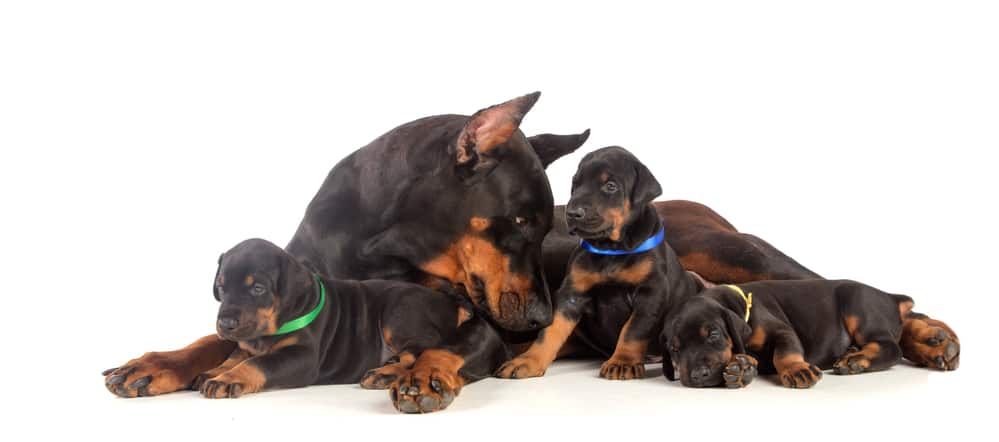
During the fifth month, weaning is progressing in all earnestness. Mom only nurses her puppies once or twice during the day. The puppies are eating puppy mush and are given water to drink.
By 6 weeks the weaning is completed and most puppies now weigh around 8 pounds. They are now very active, play around and demand attention and interaction.
Between 7-9 weeks, the ear crop will be done that gives them their characteristic Doberman look.
4 Months – 6 Months
At around 5 to 6 months, the puppy will be down to two meals a day with some snacks between meals. At this stage, it’s important to be careful with the snacks so the puppy doesn’t put on too much weight. If you can’t feel his ribs, he’s gaining too much weight.
By six months, Doberman puppies usually have most of their permanent teeth. By this time, the ear crop should have resulted in ears standing up.
According to some resources, males should be neutered and females are ready to be spayed by six months of age, other resources say six months is too early. Females usually experience their first heat cycle between 6-8 months, but it can also happen later, especially in larger sized females.
7 Months – 9 Months
During these months females are reaching their full adult height and they weigh between 56 and 64 pounds. Males weigh on average between 65 and 75 pounds but will only reach full height at around 18 months.
Doberman owners use this general rule to work out the growth rate of the average Doberman: they put on around ten pounds every month. That means your puppy should weigh 30 pounds at three months of age, and around 70 pounds at seven months. This rule is more or less accurate until eight months when weight gain starts slowing down.
10 Months – 12 Months
At this stage, Doberman puppies continue to mature. They are bonding with their owners and they are old enough to be neutered/spayed.
Adult
Once your puppy turns one year old, he is considered an adult, however, he is not fully mature yet and has some growing to do still. He is also not mentally mature yet.
Around this age, the dog has bonded with its owner and will have become a loyal companion. Your dog will love to spend time with you and will be very protective. Your dog needs a lot of attention and interaction with you.
At 12 months, a Doberman has reached his mature height, but will continue to fill out. He matures over the next year. A male is considered in his prime at about age 3 years of age and a female at about age 2 to 3 years.
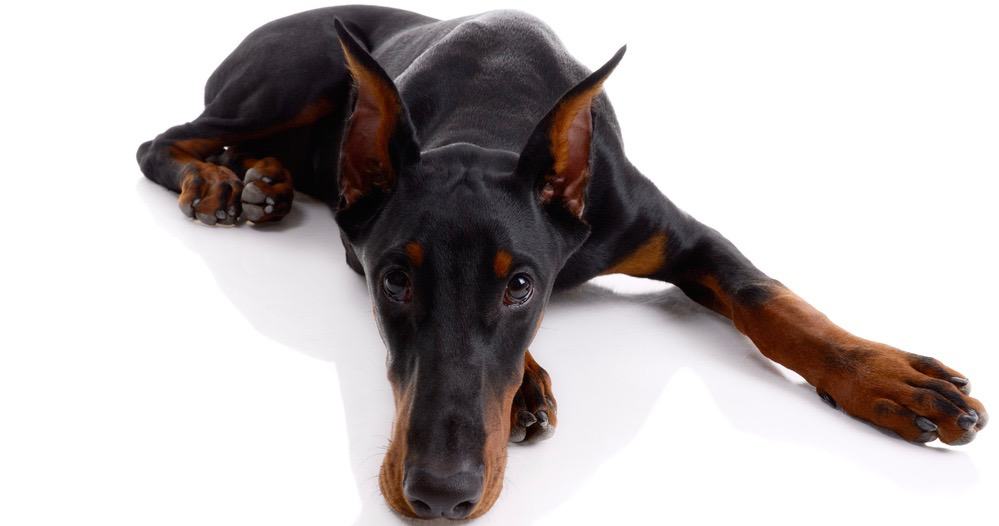
What If My Doberman Is Not the Right Weight?
To know if your dog is the right weight, consult the Doberman growth chart. That should give you a general indication. However, it’s a very general guideline and weights can differ quite a lot and still be in the acceptable range.
For this reason, you should look at the general condition of your dog and his body shape. You should be able to see from his body whether he’s the right weight. A better option for judging your Doberman’s weight would be to consult a body condition chart.
You judge your dog’s weight by its physical appearance. A body condition chart is really helpful since you don’t need a scale, just look at your dog’s body shape.
Your dog is the right weight when:
- You can feel his ribs and they are not hidden under fat.
- You can see his waist when you view him from above.
- His stomach is tucked up when you look at him from the side.
If you suspect that your dog is not the right weight, consult your vet for advice on diet, treatment, and exercise.
When Is A Doberman Fully Grown?
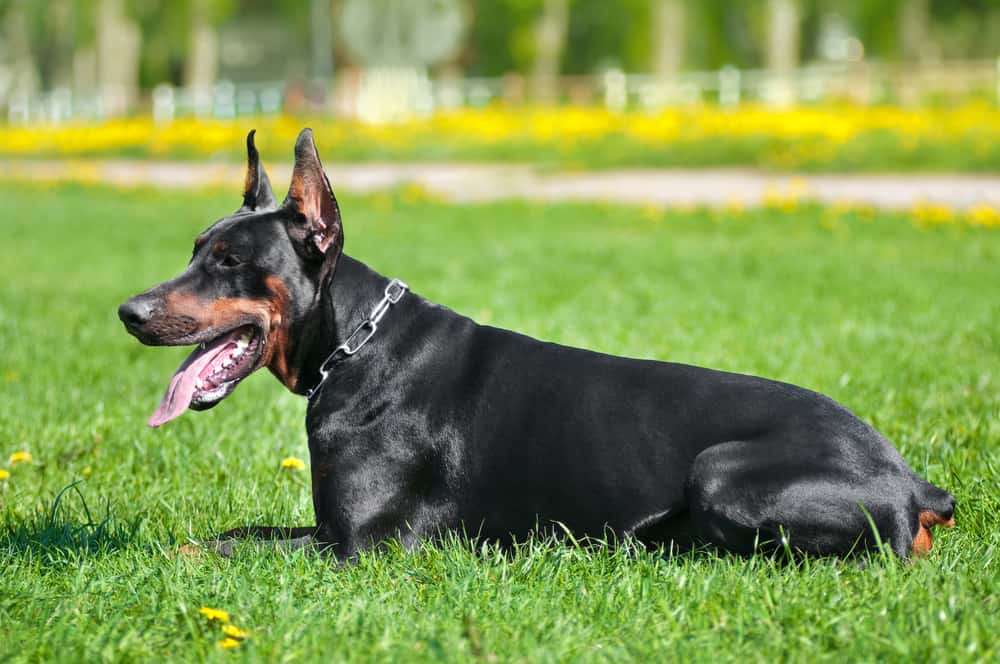
Females usually reach their adult height between 7 and 12 months of age. However, their bodies keep growing and they grow a bit thicker until they’re about 2 years old.
Male Dobermans also reach their adult height between 7 and 12 months of age, but they continue to grow and develop thicker bodies over the following months. Some males also continue to grow a little bit in height.
Some dogs keep on growing gradually thicker until they’re 2 years old.
Do Dobermans Still Grow After Being Neutered & Spayed?
A common question that we have seen is whether your Doberman puppy will continue to grow once he has been spayed or neutered.
The short answer is yes, he will continue to grow once he has been spayed or neutered, but there are other factors to consider.
When it comes to large breed dogs, spaying or neutering them after they have finished growing is ideal. This is usually after a year of age. For females, it would be after her first heat cycle at the least.
This is because studies have shown that if large breed dogs are spayed or neutered early, there is a negative effect on the growth plates in their joints, resulting in joint issues as they age.
How Big Do Dobermans Get?
While you already know that Dobermans are a large dog breed, you might still want to know how large your puppy is going to get. The first place to check is a Doberman growth chart, where you can compare your dog’s current stats to future stats by following the growth curve.
Beyond a growth chart, if you are able to look at your dog’s parents, you will have a better idea about how large you can expect the puppy to be.
Large paws on a puppy are also a big indicator that you are going to have a large dog, as the puppy will need to grow into them. Some DNA tests might be able to provide insight as well as where your dog’s genetics are at.
Doberman Size Chart
When measuring the height of a Doberman, you will measure at the withers, which is the highest point on the Doberman’s body. The average height of a male Doberman is between 26 and 28 inches, but the American Kennel Club states that 27.5 inches is the ideal height of a male Doberman.
Female Dobermans are shorter by comparison. They stand between 24 and 26 inches tall, with the ideal height for a female listed at 25.5 inches tall. The height difference between a male and female is small.
European Dobermans average about one inch taller in height than the American Dobermans, putting the males closer to a max height of 29 inches and 27 inches for females.
How To Properly Weigh A Doberman
If you want to keep track of your Doberman’s weight, you will need to know how to properly weigh him.
The first thing is that if your Doberman is a puppy or if you are just large enough to hold your dog, you should be able to weigh him at home. To do this, you can use your regular bathroom scale.
First, weigh yourself and write it down. Then, pick up your dog and hold him while standing on the scale. The difference in the weights is how much your dog weighs.
If your dog is too large to hold, you can either invest in a dog scale, which can run over $100, or you can pay a visit to your vet. Most veterinarian offices will allow you to come in to use their scale.
For an adult Doberman, unless there is a health concern, you can weigh him once every six months. For a puppy, once a week is good to make sure he’s on his growth curve.
What Is A Doberman’s Neck Size
When it comes to your Doberman’s neck, it is important to know its size in order to buy him the appropriate collar size. Too large of a collar, and he will slip out. Too small and he will be uncomfortable.
You can simply measure your dog’s neck using a tape measure, going around the circumference. Do it in the area above the shoulders, where your dog will wear his collar, and then compare the inches to the dog collar size chart.
On average, a Doberman’s neck is between 16 and 18 inches in diameter, but this varies between dogs.
Doberman Body Condition Score (BCS)
If you are familiar with the Body Mass Index (BMI) used in humans to determine weight health, then you should know about the Body Condition Score (BCS) used to make sure dogs are a healthy weight. It is not as straightforward in dogs, because of the variety of sizes, so we are going to look at just the Doberman BCS.
The BCS scale runs from 1 to 9. 1 is the lowest weight score and indicates that a dog is emaciated with no fat and a loss of muscle mass. On the other end of the spectrum, 9 is severely obese, where the ribs cannot be felt under all of the fat that is on your dog and there is no visible waist at all.
Ideally, your dog should be a 5 on the scale. This is where your dog’s body is well-proportioned and healthy. You should be able to feel the ribs, but not see them protruding. You can see your dog’s waist behind the ribs when you look at him from above.
How To Help Your Doberman Lose Weight If He Is Overweight
If your Doberman is overweight, it is best to help him shed the extra pounds. Unless there is an underlying health condition, dogs become overweight just like humans do: through overeating and too little movement.
Here are some things that you can do to help your Doberman lose weight:
- Talk to your vet. The first thing is to confirm with your vet your dog’s ideal weight and her recommendation to get your dog on a healthy path.
- Cut back on the treats. If you are giving your dog a lot of treats, it would be good to cut back or review the type that you are giving him.
- Switch up his food. If you are overfeeding him, your vet will likely ask you to reduce his food by as much as 10%. If not, you can feed him like normal in the morning, but in the afternoon, reduce the amount of kibble, but add in green beans, carrots, or apples to give him more nutrients and fewer calories.
Factors That Affect Doberman Puppy Growth
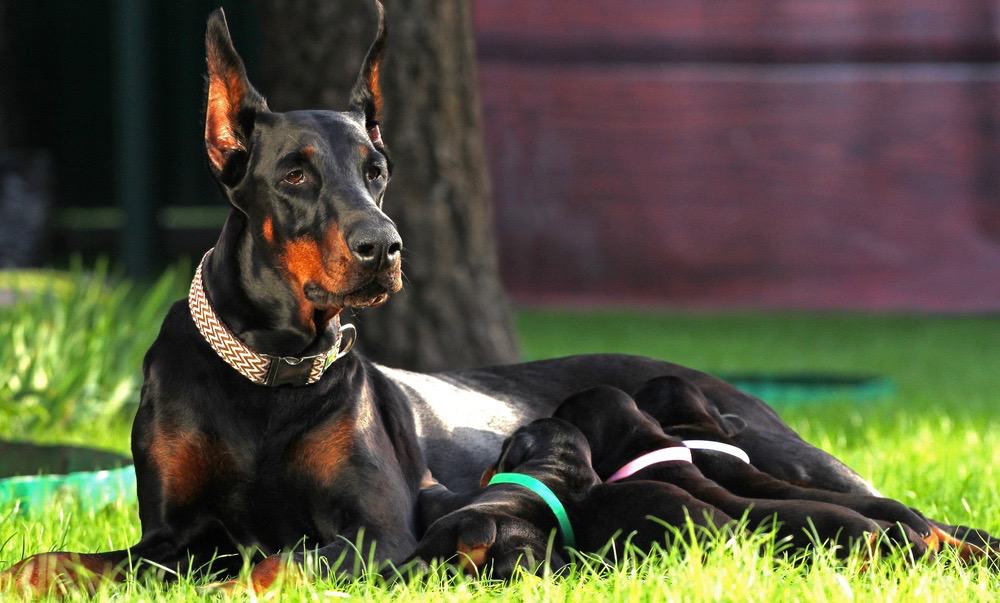
Genetics
Some Dobermans are larger than others. This is because of breeding. They will be larger in appearance and also weigh more. There have been cases of dogs weighing up to 120 pounds but that is unusual.
Nutrition
Dobermans are naturally sleek dogs and will maintain their slim profile if they receive well-balanced dog food high in nutrition but not high in calories.
Physical Activity & Health
Mature Dobermans need at least two hours exercise every day. If they don’t get enough exercise, they can get sluggish and put on unnecessary weight. Make sure you exercise your dog enough. Without enough exercise, he won’t be healthy.
How Long Are Dobermans Pregnant?
The normal gestation period for dogs is approximately 63 days from conception. However, gestation can be shorter or longer and the date of conception is not always an accurate date to time the birth.
This is because conception doesn’t necessarily happen when mating happens. Sperm can stay alive for several days inside the female, and eggs themselves can be fertile for up to two days. This means that the day of mating is not an accurate measure of when conception took place. It’s best to consult a vet to determine the length of gestation.
How Many Puppies Do Dobermans Have?
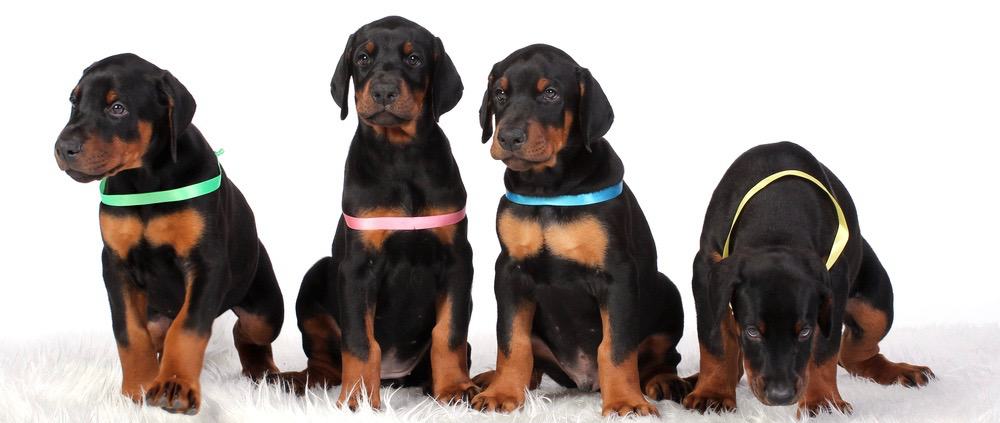
Dobermans are physically strong and generally have healthy litters. Females usually give birth to litters of six to eight puppies. The litter is usually healthy. Dobermans are popular with breeders as they are uncomplicated dogs to breed.
What Is The Life Expectancy Of A Doberman?
Dobermans don’t live very long. The average Doberman lifespan is 10 – 13 years. Depending on genetic factors and level of care, some individuals can live up to 13 years.
How Much Does It Cost To Own A Doberman?
The average price of a Doberman puppy that you buy from a reputable breeder is between $1,500 and $2500, depending on whether your dog will be a pet or a show dog.
A bag of food will set you back $85 and treats will be around $20. You need to buy a dog bed ($30 +) and dog bowls & leash ($50).
Don’t forget the first visit to the vet and the first vaccines. Then there are the deworming, flea & tick medication as well as the dog license. You do the math!
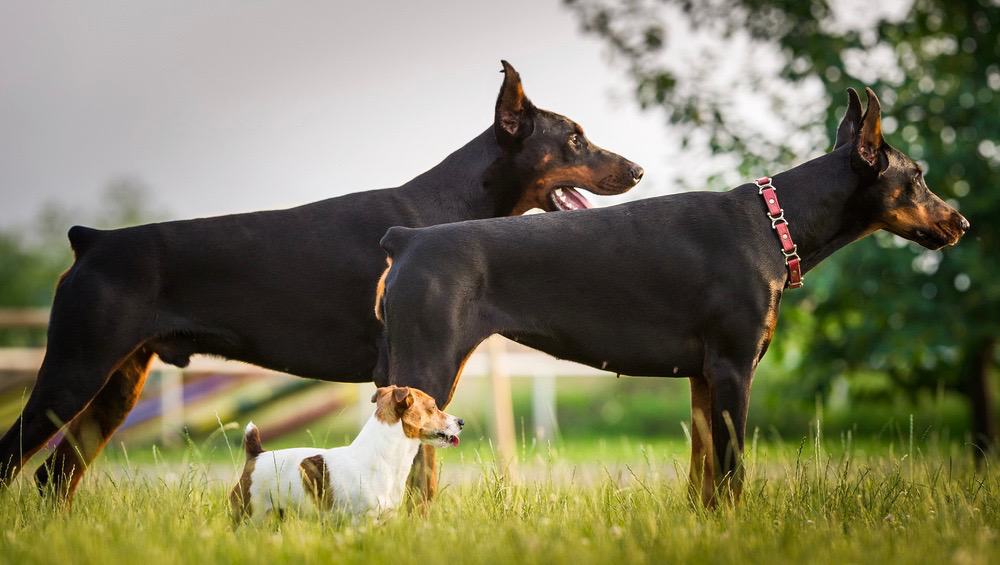
Doberman Genetics and Common Health Problems
Routine veterinary examinations are very important for Dobermans. Common diseases they can suffer from include dilated cardiomyopathy, which is a disease of the heart muscle, hypothyroidism, Wobbler syndrome, color dilute alopecia, and Dancing Doberman Syndrome.
Von Willebrand’s disease is a bleeding disorder, similar to hemophilia in humans. If your dog loses hair and becomes overweight it might be a sign of hypothyroidism. You can suspect that your dog has Wobbler syndrome if his neck seems stiff and sore.
Color dilute alopecia appears in blue and fawn Dobermans and manifests in a poor and patchy coat. With Dancing Doberman Syndrome dogs begin to flex and straighten first one and then both hind legs when they stand.
Frequently Asked Questions
What Are The Best Foods For A Doberman’s Diet?
It’s important to give your Doberman the right food to help them maintain a healthy weight and get all the nutrition it needs.
Giving your Doberman the proper foods (in the right quantities) will make sure they stay in the best health possible. Dobermans need a balanced diet that includes protein, vitamins, minerals, fiber and water.
Store-bought dog foods that are suitable for Dobermans (always check to make sure it’s the right variety of dog food) will typically contain all the required nutrients that your Doberman needs.
These should include a source of protein such as chicken, beef, or turkey, along with whole grains like brown rice or other fiber-heavy foods like sweet potato.
If you’re concerned about the dietary needs of your Doberman, check with your vet to discuss the right foods to feed your dog.
What Supplements Do Doberman Puppies Need For Healthy Growth?
Before a young Doberman reaches maturity, it needs to have the right nutrients to ensure healthy and proper growth.
However, your Doberman might not be getting all the vitamins and other nutrients that it needs from its diet alone, and you may need to give your Doberman puppy some additional supplements as it develops.
Most Doberman puppies won’t need supplements as long as they have a balanced diet, but adult Dobermans and some puppies can benefit from the additional nutrition.
Dobermans benefit from the same types of vitamins and minerals as other types of dogs. These include calcium, and vitamins B, C, and A. Again, your Doberman shouldn’t need supplements as long as you’re supplying them with the right diet.
Giving your Doberman unnecessary supplements can be harmful to their health; consult a vet before giving your Doberman supplements.
How Do You Get A Doberman To Gain Weight?
Just like you shouldn’t let your dog get overweight, it’s important to make sure your Doberman has enough weight on it to be healthy.
A good middle-ground is perfect for a Doberman, but if your dog is underweight then you need to improve its diet to get it to a healthy level.
The most simple way to get a Doberman to gain weight is to increase the amount of food you give them.
Gradually up how much food they get each meal, without too much more at once; a large jump in food quantity can cause problems for your Doberman in itself.
The foods you feed your Doberman also have an effect, and you may need to increase how much healthy proteins and fats in their diet if they aren’t at the appropriate weight.
If you’re concerned by your Doberman’s weight, consult your vet – some health issues like parasites and nutrient deficiencies could be causing your Doberman to be underweight.

